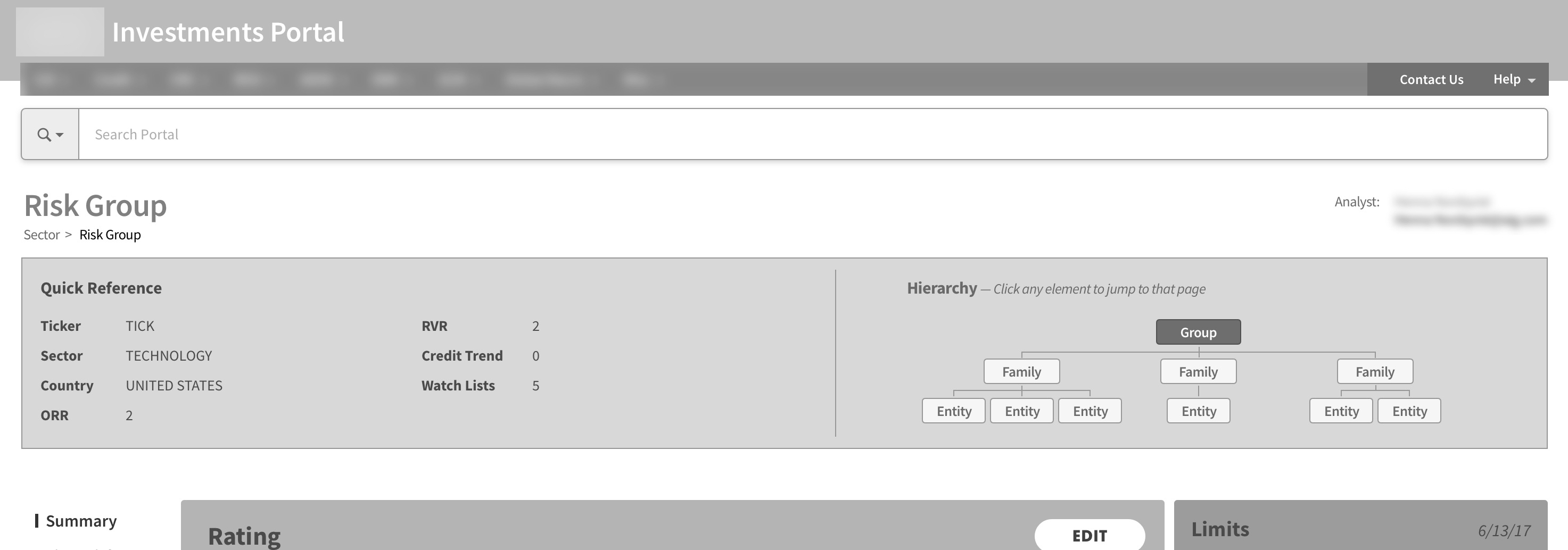User Experience Research, UX Design, Strategy | 2017-2018
User Experience Research |UX Design, Strategy |2017-2018
Investments Portal
Investments Portal Research
The Set-up
The Set-up
Disclosure: this project has been scrubbed of details due to company policy.
The investments and risk management businesses work closely with one another, often measuring, tracking, and analyzing many of the same positions and portfolios. However, neither maintain a successful application strategy or a useful digital platform – a clear cost to efficiency and performance. I undertook a full-scale research initiative to understand the wide array of user’s needs and workflows to develop a foundation from which we can design a new platform for both businesses.
Disclosure: this project has been scrubbed of details due to company policy.
The investments and risk management businesses work closely with one another, often measuring, tracking, and analyzing many of the same positions and portfolios. However, neither maintain a successful application strategy or a useful digital platform – a clear cost to efficiency and performance. I undertook a full-scale research initiative to understand the wide array of user’s needs and workflows to develop a foundation from which we can design a new platform for both businesses.
Disclosure: this project has been scrubbed of details due to company policy.
The investments and risk management businesses work closely with one another, often measuring, tracking, and analyzing many of the same positions and portfolios. However, neither maintain a successful application strategy or a useful digital platform – a clear cost to efficiency and performance. I undertook a full-scale research initiative to understand the wide array of user’s needs and workflows to develop a foundation from which we can design a new platform for both businesses.


Attacking the problem
Attacking the problem
Designing the study came with a number of challenges. First, not only did we need to understand how the two (rather complex) businesses operate, but that within each business contains a very wide variety of user types, each with drastically different requirements, needs, and perspectives of handling data. While the process can account for this, it became a challenge because of the limited access to our end users who are typically pressed for time.
The entire research process included interviews with end users and stakeholders, workflow workshops, co-design sessions, and observational studies. However, in order to better understand the businesses we had a number of “deep-dives” with SMEs who understand the tools, data systems, and processes.
Designing the study came with a number of challenges. First, not only did we need to understand how the two (rather complex) businesses operate, but that within each business contains a very wide variety of user types, each with drastically different requirements, needs, and perspectives of handling data. While the process can account for this, it became a challenge because of the limited access to our end users who are typically pressed for time.
The entire research process included interviews with end users and stakeholders, workflow workshops, co-design sessions, and observational studies. However, in order to better understand the businesses we had a number of “deep-dives” with SMEs who understand the tools, data systems, and processes.
Designing the study came with a number of challenges. First, not only did we need to understand how the two (rather complex) businesses operate, but that within each business contains a very wide variety of user types, each with drastically different requirements, needs, and perspectives of handling data. While the process can account for this, it became a challenge because of the limited access to our end users who are typically pressed for time.
The entire research process included interviews with end users and stakeholders, workflow workshops, co-design sessions, and observational studies. However, in order to better understand the businesses we had a number of “deep-dives” with SMEs who understand the tools, data systems, and processes.
How can we account for everyone?
How can we account for everyone?
Traders, analysts, CIOs, COOs not only need different data depending on asset classes and roles, but also analyze it through unique lenses. As important as it is to get aduquate representation from all our users, we knew that resources and timing would limit our ability to do so. We decided to supplement our interviews with in-depth workflow workshops with multiple users of each user type. This was the most useful way identify areas of workflows to prioritize. We first uncovered all the tasks users would perform over various periods of time, and then drilled down into one or two to extract the details.
We tracked the results using Realtimeboard and made visual representations of highlighted flows in Sketch.
Traders, analysts, CIOs, COOs not only need different data depending on asset classes and roles, but also analyze it through unique lenses. As important as it is to get aduquate representation from all our users, we knew that resources and timing would limit our ability to do so. We decided to supplement our interviews with in-depth workflow workshops with multiple users of each user type. This was the most useful way identify areas of workflows to prioritize. We first uncovered all the tasks users would perform over various periods of time, and then drilled down into one or two to extract the details.
We tracked the results using Realtimeboard and made visual representations of highlighted flows in Sketch.

Diagram of a CIO workflow.
Realtimeboard of a single CIO's workflow.

Diagram of a PM workflow.
Realtimeboard of a single CIO's workflow.
Design Studio
Design Studio
We decided to hold an unconventional design studio with SMEs for a variety of reasons. First, we wanted to validate the direction our findings were leading us, and although we took many measures to make sure these findings weren't being skewed towards one particular business or user type, the studio helped level-set our process. Additionally, we were able to leave the four hour session with tacticle designs in-hand.
We decided to hold an inconventional design studio with SMEs for a variety of reasons. First, we wanted to validate the direction our findings were leading us, and although we took many measures to make sure these findings weren't being skewed towards one particular business or user type, the studio to level-set our process. Additionally, we were able to leave the 4 hour session with short-term tacticle designs in hand.
Observational Research
Observational Research
Oftentimes, user behavior can't be truly discovered through simple interviews and workshops. Observational studies helped us understand how each user type interacts and navigates through these expert sytems. We learned that employees had been underestimating the difficulty they had with the reporting tools and that their workarounds were causing extraordinary inefficiencies throughout the entire system and their processes.
Oftentimes, user behavior can't be truly discovered through simply interviews and workshops. Observational studies helped us understand how each user type interacts and navigates through these expert sytems. We learned that employees had been underestimating the difficulty they were experiencing with the reporting tools and that their workarounds were causing extraordinary inefficiencies throughout the entire system.

Sample wireframe resulting from design studio with SMEs.
Sample wireframe resulting from design studio with SMEs.
Implementing better methods for tracking findings
Implementing better methods for tracking findings
We needed better methods of storing and tracking qualitative data, as we were gathering enourmas amounts of it. I went ahead and built a multisheet tracking system using Airtable, where you can input, organize, and tag findings so that we could closely follow Atomic Research principles. By automating a coding system, referencing and organizing our sources was a simple and hasslefree task, making synthesis much more efficient.
We needed better methods of storing and tracking qualitative data, as we were gathering enourmas amounts of it. I went ahead and built a multisheet tracking system using Airtable, where you can input, organize, and tag findings so that we could closely follow Atomic Research principles. By automating a coding system, referencing and organizing our sources was a simpler and hasslefree task, making the synthesis process much more efficient.

What we found
What we found
Through thorough analysis of our data, we uncovered a number of pain-points, communication, performance, and workflow inefficiencies that bottle-necked the two businesses. This made it apparent that in order to best serve the needs of the users and businesses alike, a holistic application strategy must first be developed. A single source of truth and a shared platform would ultimately benefit the Investments and Risk Management, however, it would be a disservice to not first attack the workflow inefficiencies that plague the system throughout.
In other words, we set out to answer a question and in doing so realized the problem is much bigger than that question accounted for. My team and I were able to present our findings to the business along with actionable next-steps. This resulted in approving further work where we'll begin to shape a holistic application strategy and continue research to understand the upstream data systems that feed the end users we hope to affect.
Through thorough analysis of our data, we uncovered a number amount of pain-points, comminucation, performance and workflow inefficiencies that bottlenecked the two businesses, making it apparent that in order to best serve the needs of the users and businesses alike, a wholistic application strategy must first be developed. Investments and Risk Management desparately need a single source of truth and would benefit immensley by sharing a platform, it would be a disservice to not focus the workflow inefficiencies that plague the system throughout first.
In other words – we set out to answer a question, and in doing so realized the problem is much bigger than that question accounted for. My team and I were able to present our findings to the business along with actionable next-steps. This resulted in approving further work where we'll begin to shape a holistic application strategy and continue research to understand the upstream data systems that feed the end users we are concerned with.







